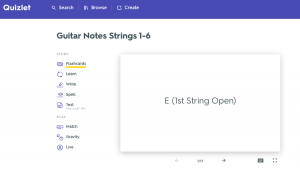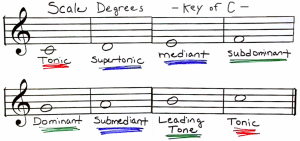School or Rock – Day 3 – Melody Basics
SUMMARY
Write your daily summary last, at the end of the day here… Only one to two sentences.
CLASSROOM
Watch How Melody Works (47 minutes)
Write notes of topics you want to remember.
- 5 notes that we use most common are the Pentatonic notes which are A, C, D, E, and G
- it doesn’t mater how much notes you have ina song, it maters how you use them
- the ionian scale is now the major scale
LAB
I did really good on making Twinkle Twinkle. I used my previous knowlege of the song since I play the cello and I know the notes to it. I used Hookpad and was able to successfully make the song.
PRACTICE ROOM

This was great, I’ve used Quizlet before so I knew how it worked. The flashcards are great to use and the games and quizes they have to help you remember and retain the information.
OUTSIDE / JOURNAL / IDEAS
When Elizabeth Gilbert was talking about a poet who lived in Virginia and that she could literally grab the words she wants to use in her poem. I think really shows that she was very creative
STUDIO
Melody Composition Terms
- Theme – a longer, more flowing melodic idea
- Motive- a short rhythmic idea
- Period- a 8 measures of music
- Phrase- 4 measures of music
- Antecedent (Question) Phrase- the first phrase, the start
- Consequent (Answer) Phrase- the answer phrase, which finishes
- Scale Degrees
- Tonic- begins and ends
- Supertonic, Mediant, Submediant- has a moderate tension
- Dominant, Subdominant, Leading Tone- very high amount of tension
- Steps- any movement using half or whole steps
- Leaps- any movement using intervals bigger than a whole step
- Conjunct motion- a melodyout of steps
- Disjunct motion- leaps in the melody
- Repetition- use repeated material to create a link between 2 phrases of a period
- Contrast- 2 phrases with contrasting material which will create tension
- Variation- half way between repetition and contrast. The 2 phrases include some recognizable material and some varied material
Melody Resources


Mr. Le Duc’s Key of C Major Notes and Chords Chart (PDF)
CONTROL ROOM
Learn how to Create Tracks
Explore the Piano Roll, Drawing and Moving Notes
Learn to Edit Notes, Velocity, and More
Learn to Create Your Own Presets
the proccess of switching between different instruments is great. It is lots of fun to play with them without physically learning a whole new instrument. when recording if you mess up you can go back and edit your notes which is amazing, so instead of replaying the whole song you want to play, you just can go back and make the note longer or shorter. This was really good.
WHAT I LEARNED and PROBLEMS I SOLVED
Tell your daily story here! Highlight what you learned and enjoyed most. Problem-solving is one of the most important skills you need in life. Employers want to know HOW you get stuff done as much as WHAT you got done.
I learned that the main 5 notes that are used to most comonly are A, C, D, E, and G. I did not run into any problems, things went rather very smoothly.